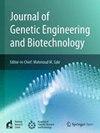Assessment of the gold nanoparticles biosynthesized using Casuarina equisetifolia bark extract against the ethion induced Hepato- and neurotoxicity in rats
IF 2.8
Q3 Biochemistry, Genetics and Molecular Biology
Journal of Genetic Engineering and Biotechnology
Pub Date : 2025-04-24
DOI:10.1016/j.jgeb.2025.100495
引用次数: 0
Abstract
Ethion (Etn) is classified as an organophosphate pesticide (OP) that causes toxicity even at low concentrations and targets the liver, brain, kidney, and blood. Gold nanoparticles (Au-NPs) were biosynthesized from the whole methanolic extract of Casuarina equisetifolia bark, and their efficacy against Etn-induced hepato- and neurotoxicity in rats was assessed. In addition to determining conventional biochemical measurements, the target tissues (liver and brain) were examined for oxidative stress, inflammatory, and fibrotic markers. The protein and isoenzyme patterns were also assayed using an electrophoretic technique. Additionally, apoptotic gene expression was measured. The target tissues were also subjected to histopathological analysis. In all groups treated with C. equisetifolia bark gold nano-extract, it was observed that the levels of the hematological measurements that were impacted by the oral injection of Etn had recovered to normal. Regarding the biochemical measurements, the group that received nano-extract pretreatment showed greater improvement than the therapeutic group. The levels of inflammatory indicators significantly decreased (p ≤ 0.05), while the antioxidant system markers increased in both liver and brain tissues in the group that received the nano-extract beforehand. In both target tissues, especially in the pre-treated group, the nano-extract reduced the severity of the Etn-caused lesions. During electrophoretic assays, the nano-extract in the pre-treated group prevented the qualitative alterations indicated by the lowest similarity index (SI%) values of the Etn-injected group compared to the normal group. The molecular assay showed that the nano-extract reduced the expression of apoptotic genes that were markedly elevated in the Etn-injected rats, but it was unable to return their values to normalcy. The study concluded that in the group that received nano-extract pretreatment, the biochemical, histopathological, physiological, and molecular abnormalities caused by Etn were reduced by the C. equisetifolia bark gold nano-extract.

木麻黄树皮提取物生物合成金纳米颗粒对乙硫醚诱导大鼠肝毒性和神经毒性的影响
乙硫磷(Etn)被归类为有机磷农药(OP),即使在低浓度下也会产生毒性,并以肝、脑、肾和血液为目标。以木麻黄树皮全甲醇提取物为原料合成金纳米颗粒(Au-NPs),并对其抗etn诱导的大鼠肝毒性和神经毒性进行了研究。除了常规的生化测量外,靶组织(肝脏和大脑)也被检测氧化应激、炎症和纤维化标志物。蛋白质和同工酶模式也用电泳技术测定。此外,检测凋亡基因表达。靶组织也进行了组织病理学分析。经皮金纳米提取物治疗的各组小鼠血液学指标均恢复正常。在生化指标方面,纳米提取物预处理组比治疗组改善更大。预先注射纳米提取物组大鼠肝脏和脑组织炎症指标水平显著降低(p≤0.05),抗氧化系统指标水平升高。在两个靶组织中,特别是在预处理组,纳米提取物降低了etn引起的病变的严重程度。电泳分析中,预处理组的纳米提取物阻止了etn注射组与正常组相比的最低相似指数(SI%)值所表明的质变。分子实验结果表明,纳米提取物可降低etn注射大鼠细胞中凋亡基因的表达,但不能使其恢复正常。本研究得出,在接受纳米提取物预处理的组中,木贼皮金纳米提取物可减轻由Etn引起的生化、组织病理、生理和分子异常。
本文章由计算机程序翻译,如有差异,请以英文原文为准。
求助全文
约1分钟内获得全文
求助全文
来源期刊

Journal of Genetic Engineering and Biotechnology
Biochemistry, Genetics and Molecular Biology-Biotechnology
CiteScore
5.70
自引率
5.70%
发文量
159
审稿时长
16 weeks
期刊介绍:
Journal of genetic engineering and biotechnology is devoted to rapid publication of full-length research papers that leads to significant contribution in advancing knowledge in genetic engineering and biotechnology and provide novel perspectives in this research area. JGEB includes all major themes related to genetic engineering and recombinant DNA. The area of interest of JGEB includes but not restricted to: •Plant genetics •Animal genetics •Bacterial enzymes •Agricultural Biotechnology, •Biochemistry, •Biophysics, •Bioinformatics, •Environmental Biotechnology, •Industrial Biotechnology, •Microbial biotechnology, •Medical Biotechnology, •Bioenergy, Biosafety, •Biosecurity, •Bioethics, •GMOS, •Genomic, •Proteomic JGEB accepts
 求助内容:
求助内容: 应助结果提醒方式:
应助结果提醒方式:


